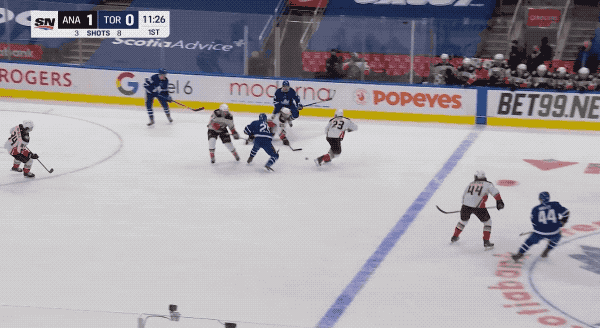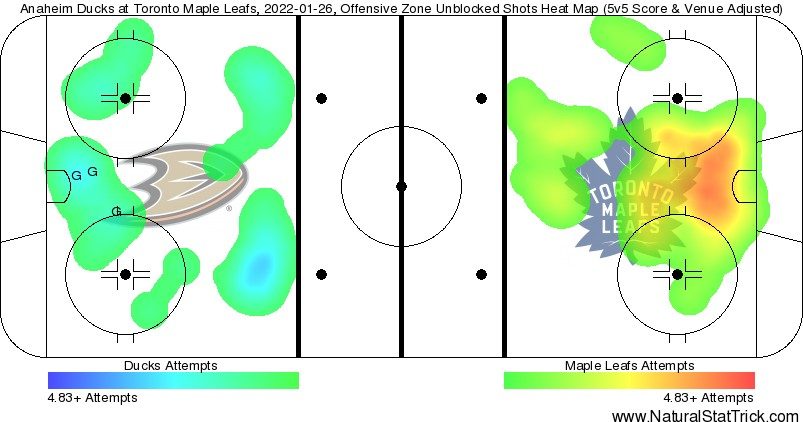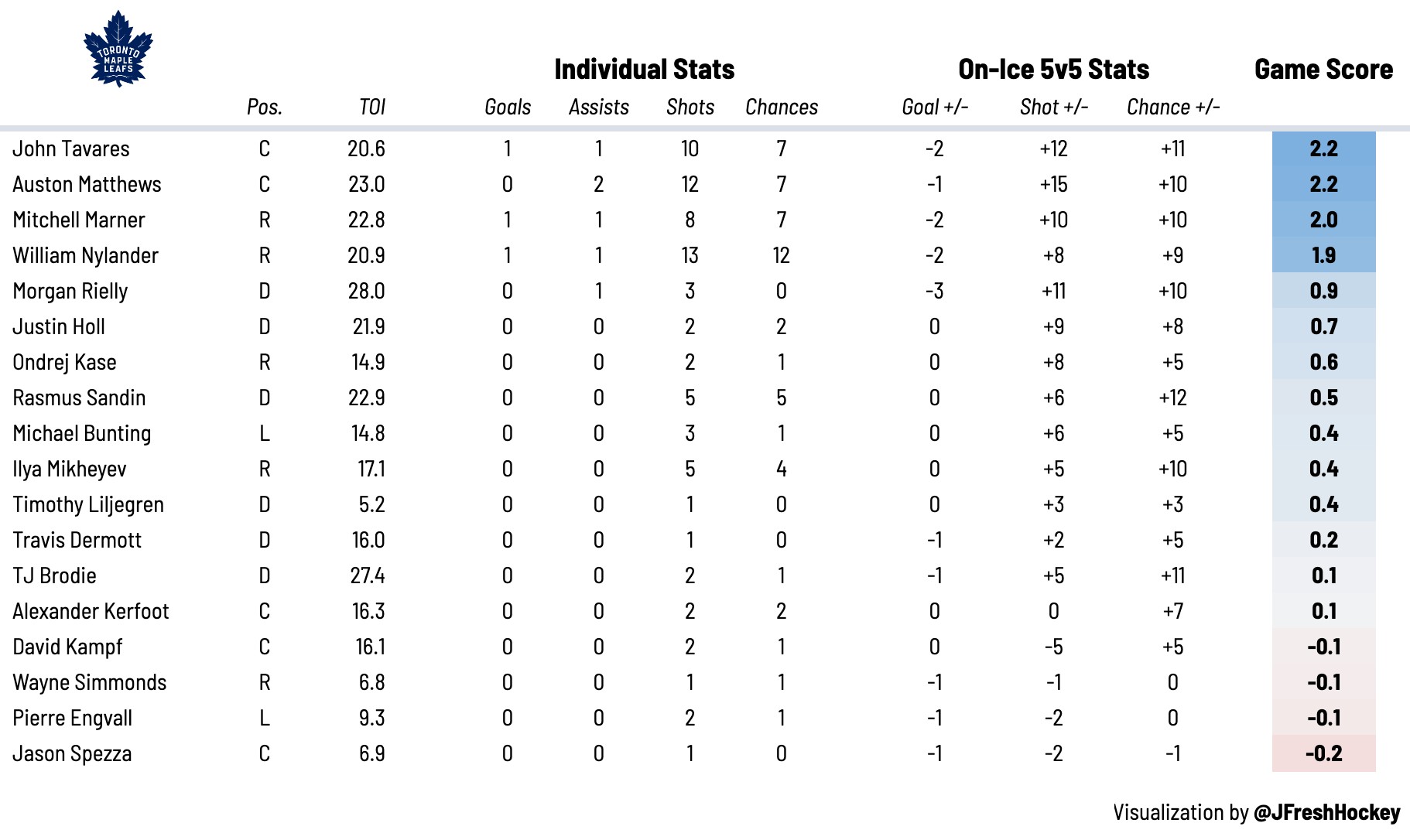Sometimes this sport doesn’t make any sense!
Actually, we could probably change that to most of the time. In a game that Toronto absolutely dominated from start to finish, the score was somehow tied after 60 minutes, resulting in five minutes of three-on-three overtime and a shootout where the Leafs ultimately prevailed.
Had they lost that coin flip at the end, does our opinion of the change drastically change?
It shouldn’t, but you’ve probably been following this team long enough to know the “narrative” doesn’t care about scoring chances or expected goals. Goaltending performance and shooting luck don’t exist in this market when the Leafs blow another 3-1 lead.
Honestly, I can understand the frustration in Toronto. This team has rarely proven an ability to overcome adversity, especially when the chips are down, so why should you accept “getting goalie’d” (again) as a reasonable explanation for what just happened?
Because it happens in this league — a lot.
If we look at the quality of the shots Toronto generated, they should have scored at least five or six goals. Replay that game 1000 times, and Toronto wins over 93% of them. The reason the score was so close last night is because one goaltender outplayed the other. That’s it.
I refuse to write a doom and gloom postgame article about the Leafs nearly losing a game where they generated 52 chances from the slot and Anaheim only had 14. It’s just not a fair assessment. With that in mind, let’s try our best to rationally break down what actually did happen on the ice.
It’s time for some Leafs Report Cards!
5 Stars
Coaching Staff — Credit where credit is due; Sheldon Keefe & Co. experimented with spreading their star talent across three lines and the final product was impressive. Each of Auston Matthews, Mitch Marner, and William Nylander were able to spearhead their line to dominate the run of play at 5v5.
More importantly, the coaching staff found a way to creatively balance the minutes of its best players. Here’s a quick breakdown of the TOI for each member of the Core Four:
- 23:02 for Matthews
- 22:48 for Marner
- 20:54 for Nylander
- 20:38 for Tavares
By getting Nylander on the ice for faceoffs out of timeouts and selectively throwing him out there with the top six (i.e. after an icing), the Leafs were able to balance three strong lines of offense at even strength while still getting their skilled players the minutes they need.
Before he got snagged up by Colorado’s analytics department, Dawson Spriggins (@DTMAboutHeart) did some great research back in 2016 to help prove that spreading your star talent across three lines was the best way to optimize results at 5v5. This was right around the time Pittsburgh was winning Stanley Cups by playing Sidney Crosby, Evgeni Malkin, and Phil Kessel each on their own line.
Toronto might be smart to follow that blueprint, especially if they can keep getting Nylander close to 20 minutes a night while doing so.
The Cour Four — Games like these are why you pay for high-end offensive talent. It’s hard to stop an onslaught of scoring chances when they come at you wave after wave. They were devastating together on the power play, helping Toronto go three for four on the power play. To help break down why each player was so impressive on Wednesday night, let’s go through them one by one.
The combination of Bunting-Matthews-Kase has been successful so far thanks in large part to Auston Matthews drawing the attention of seemingly every opposing defender, which opens up plenty of open ice for him to dish Ondrej Kase and Michael Bunting into wide open scoring chances. Matthews’ transition game through the neutral could have been better, but it’s hard to argue with his overall impact in this game when you look at the numbers. The Leafs had 15 more shot attempts and 10 more scoring chances than the Ducks when he was on the ice — that’s not a coincidence.
On Line #2, Mitch Marner was the primary driver of offense. He looked confident wheeling around the offensive zone with the puck and found open teammates with his passing. Special teams is where Marner really took over, though, pressuring Trevor Zegras on the half-wall and forcing turnovers. Marner also unleashed a bomb on the power play, which is something we’ve all been wanting to see him develop.
His linemate, John Tavares, had a typical strong Tavares game. He was getting open in the slot and generating tons of quality chances. I was also quite impressed with his ability to make plays off the rush, gaining the zone with his stick-handling and completing the next play to beat the defender, whether it was a pass to an open teammate or a shot through the screen.
Last but not least, William Nylander somehow managed to score only one goal in this game. The puck kept finding him in tight only for John Gibson to sprawl across and rob him time after time. He was also providing his linemates with a vertical threat, stretching up the ice and almost getting a breakaway on a few different occasions.
For anyone who watched that epic Bills-Chiefs game the other night, watching Nylander dart up the ice reminds me of watching Patrick Mahomes look for Tyreek Hill deep down the field. You know it’s coming, but it’s still so difficult for defenses to handle his speed.
TJ Brodie (RD, #78) — He just keeps making plays like these.
Killing rushes early is one of Brodie’s specialties. Even though he isn’t as strong offensively as you’d expect for a player with his mobility, he makes up for it with his stellar defending in transition.
I could clip more of these plays, but I think you get the point. His ability to make these plays helps Morgan Rielly & co. remain on the attack, knowing they have#78 to clean things up defensively in the neutral zone.
4 Stars
Rasmus Sandin (LD, #38) — After getting walked by Zegras early, I was worried this was going to be a rough night for Sandin, but he really kicked things into gear after that shift. Much like Rielly, he was looking for every opportunity to jump up into the rush as the fourth forward, which helped the Leafs create numerous odd-man rushes with Sandin as the trailer.
There were a few shifts where Toronto had possession for the entire duration of Sandin’s shift, which speaks to his ability to get open and continue passing sequences with his vision.
Justin Holl (RD, #3) — Sandin has elevated the play of both Travis Dermott and Timothy Liljegren this season, so it shouldn’t come as a surprise that Justin Holl had one of his better games of the season alongside the smooth Swede. It was great to see Holl activating into the offensive zone on the cycle and complete the next pass to keep Toronto on the attack.
That’s the Justin Holl we know and love. He missed a pass block to the slot later in the game, which is something you’d like to see cleaned up a bit, but if he can keep activating into the play and making good decisions with the puck, the Leafs are going to have possession more often than not.
Alex Kerfoot (LW, #15) — He and Nylander are fun to watch play off of each other in transition, using their speed to get up the ice and passing ability to reverse play to the weak side when they have the chance.
This was probably Kerfoot’s best play of the game.
What a shorthanded sequence for Kerfoot, Mikheyev and Brodie pic.twitter.com/ZsBcx0PaO6
— Omar (@TicTacTOmar) January 27, 2022
Right before this, he stole the puck on a PK forecheck and completed a pass back to his defenseman, which started up this whole sequence. As much as I’ve criticized his unsustainable shooting luck at 5v5 this season, I have to give him credit for the value he’s provided at 4v5. He’s been one of Toronto’s best penalty killers in 2021-22.
3 Stars
The Bunting-Kase Duo — Spreading your star talent requires role players to play a bit higher in the lineup than they’re used to, but we’ve had a chance to see these two perform well alongside Matthews in 67 minutes together this year. It’s not a massive sample size, but it’s enough for us to estimate that their current rate of controlling 60% of the quality chances at 5v5 isn’t a fluke, especially with #34 centring the line.
As always, Michael Bunting got under the opponent’s skin and drew a penalty, leading to this excellent observation from Luke Fox.
Penalties drawn leaders:
1. Connor McDavid (26)
2. Michael Bunting (25)— luke fox (@lukefoxjukebox) January 27, 2022
There you have it, the best player in the world — and Connor McDavid.
It wasn’t Ondrej Kase‘s most impactful night on Wednesday, but he did get himself below the goal line and thread a few passes out front. One of them was on a play where Kase kamikazed his way through the net, knocking it off its mourings, because of course Ondrej Kase did that.
Ilya Mikheyev (LW, #47) — He didn’t always complete his pass off the rush when his more talented linemates were on a roll in transition. That said, I didn’t think Mikheyev took too much away from them, considering the defensive value he was providing by pressuring puck-carriers on the forecheck and being an absolute nuisance in the neutral zone.
What if Tavares and Marner make magic happen offensively while Mikheyev provides more of the “Zach Hyman” element to the line, being first in on the forecheck and the first one back to defend the rush? Maybe it’s a combination that could be successful.
David Kampf (C, #64) — There are a lot of nights where I simply want to say, “he was David Kampf” — and it’s not meant as an insult. His game is predictable; he stays above his man in all three zones, doesn’t turn the puck over, and gets off the ice. Coaches will take that 10 days out of 10.
Morgan Rielly (LD, #44) — On a night where Toronto’s top guns were flying, I was surprised Rielly didn’t get in on the fun. He’s usually a terror in transition, but he seemed a little quieter in that department last night. He also got burned by Jamie Drysdale in a 1v1 situation in 4-on-4, but maybe that’s just me nitpicking.
2 Stars
Jack Campbell (G, #36) — Sometimes it isn’t your week, your month (.894 in January), or even your year so far (2022). I think it’s safe to say Campbell’s performance has dipped a little lately, which was inevitably going to happen considering he started the year with a .940 save percentage.
In last night’s game, the first Anaheim goal was a complete fluke and the third was an unstoppable deflection, but getting beat clean by Jakob Silfverberg from distance is definitely one you’d like your goaltender to stop. Campbell still managed to fight through an off night and pick up the W, but it’s also fair to say one more save on the 19 shots he faced in regulation would’ve prevented the game from reaching overtime in the first place.
The Fourth Line — You tell me if you think this is a good thing or bad thing: the Engvall-Spezza-Simmonds line played 5:39 together at 5v5. I guess when you have the big guns each on one line, you have to really play them, which leaves fewer minutes for your fourth line.
Frankly, they probably didn’t deserve too many minutes. Pierre Engvall fired a puck off of Jason Spezza‘s shin pad in the crease, which is as flukey as it gets, but it’s also Pierre Engvall, so I’m sure people will be frustrated with his decision making, especially his best friend, Sheldon Keefe.
I didn’t have too many notes on these guys, to be honest — particularly Wayne Simmonds, who had a quieter night than his standard.
1 Star
Travis Dermott (LD, #23) — As someone who’s been the conductor of the Travis Dermott bandwagon for years, it might be time for me to admit that he’s never going to develop the in-zone aspect of defending that you need to be reliably trusted against stronger competition. That deflection goal was because Dermott didn’t box out his man and tie up the stick in front, which he had plenty of time to accomplish.
He also got burned by Troy Terry at one point and was forced to take a penalty. To say Dermott’s play since his rookie season has been a disappointment would be an understatement.
Ungraded
Timothy Liljegren (RD, #37) — He played just over five minutes before he fanned on a pass, tripped over the red line, hit his head on an opponent’s knee, and left the game early due to concussion precautions. Somehow also earning a penalty on that play is about as bad as it gets.
He’s typically made good decisions with the puck this season, so a few bobbles in that department aren’t necessarily indicative of a larger issue.
Heat Map
Here’s a quick look at where each team’s shots were coming from at even strength, courtesy of Natural Stat Trick.
The Leafs controlled 78 percent of the scoring chances in this game, which is the highest number I can remember this season.
*quickly scrolls through game logs*
Yup, that’s their most dominant stretch of 5v5 play this season — and they didn’t even win the game in regulation.
Game Score
Game score is a metric developed by The Athletic’s Dom Luszczyszyn to measure single-game performance. You can read more about it here.
Tweets of the Night
I’m clearly obsessed with the analytical and evaluative aspect of hockey, but I also fundamentally care about issues in life that this sport has often ignored. Hearing these words from Wayne Simmonds the other day made me proud to be covering a team that genuinely cares about racism in a predominantly white sport.
Wayne Simmonds on captain John Tavares opening his availability by speaking about the racial incidents in hockey last week and how initiatives within the #Leafs organization make him feel the most comfortable he has ever been. pic.twitter.com/SxXgkYTpZW
— David Alter (@dalter) January 26, 2022
I’d love to see more of this in hockey. It’s only going to help grow the sport we all clearly love so much — why else would you still be reading this?
Leafs really need to win so I don't have to listen to analysts bend over backwards pretending Toronto didn't dominate this game from start to finish.
— Todd Leigh Offside (@Totally_Offside) January 27, 2022
Why isn’t it okay to admit that one team can dominate the game and not win in regulation?
the glove save was good but the toss after got me pic.twitter.com/2okSjYPVMT
— Dimitri Filipovic (@DimFilipovic) January 27, 2022
It isn’t real, five-on-five, playoff hockey, but it’s some pretty cool stuff.
I’m sure we’ll hear a lot tomorrow about how it’s time to worry that the Leafs can’t hold leads, but I don’t think there’s much more to this game than Anaheim’s goalie was great and Toronto’s wasn’t.
— draglikepull (@draglikepull) January 27, 2022
That’s exactly what happened and it’s why this sport can be so random at times. Goaltending performance is so volatile, it might as well be a cryptocurrency.
This was the most Jack Campbell way to approach a confrontation. pic.twitter.com/KA6Zlpv6Zs
— Nick DeSouza (@NickDeSouza_) January 27, 2022
That’s Jack Campbell’s equivalent of a middle finger. Watch out Rickard Rakell; he might wink at you next time.















![John Gruden after the Leafs prospects’ 4-1 win over Montreal: “[Vyacheslav Peksa] looked really comfortable in the net… We wouldn’t have won without him” John Gruden, head coach of the Toronto Marlies](https://mapleleafshotstove.com/wp-content/uploads/2025/09/gruden-post-game-sep-14-218x150.jpg)




















